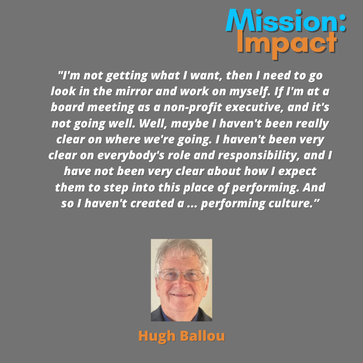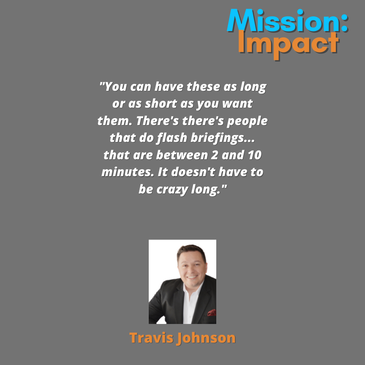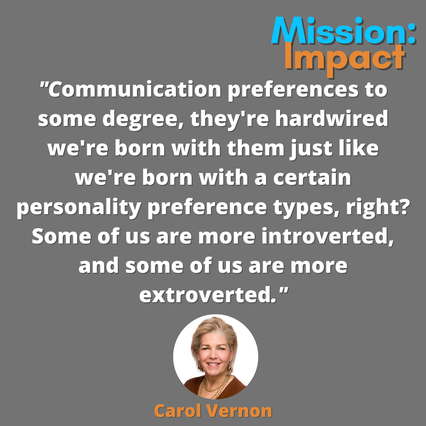Mission: Impact podcast & blog
Build a better world without becoming a martyr to your nonprofit cause
Listen on:
 In episode 59 of Mission: Impact, Carol and her guest, Hugh Ballou discuss:
Guest Bio: Hugh Ballou works with visionary leaders and their teams to develop a purpose-driven high-performance culture that significantly increases productivity, profits, and job satisfaction. through dramatically decreasing confusion, conflicts, and under-functioning. With 40 years as musical conductor, Ballou uses the leadership skills utilized daily by the conductor in teaching relevant leadership skills creating a culture that responds to the nuances of the leader as a skilled orchestra responds to the musical director while allowing each person to excel in their personal discipline while empowering the culture. Important Links and Resources:
Click "Read More" for Transcript:  Brief discussion of attempted murder from 26:27 until 26:38 In episode 43 of Mission: Impact, Carol and her guest, Travis Johnson discuss:
Travis Johnson is the host of the Nonprofit Architect Podcast. Travis shares his perspective as the former Vice President of Books by Vets; a board member at the S.H.I.N.E. foundation; he’s donated over $30,000; volunteered over 1,500 hours; raised more than $500,000; helped start 6 nonprofits; event coordinator; and published author. Travis is currently serving as an active-duty officer in the United States Navy, married with two children, and on move #50. His humble beginnings include 36 moves before graduating high school at 17, 6 states, 5 foster homes, and surviving 2 murder attempts. Although this was very rough, there was always a person, group, or church willing to help him and his family. Now that he’s in a position to give back, he’s made it his mission to “Help the Helpers”. Important Links and Resources:
Episode 10: This week we’re talking to Heather Yandow.
We talked about: • What gets in the way of nonprofits hiring consultants successfully. • Why an RFP process is often not the best approach to having a great experience with a consultant. • The trends we are observing in this time of disruption. Scenario Planning: An article describing the process from MIT Sloan management school Heather Yandow brings more than 20 years of experience as an outreach coordinator, coalition leader, project manager, and fundraiser to Third Space Studio. She helps organizations with strategic planning, board development, change management, leadership development, and going from good to great. She has also served on the Board of Directors of Democracy NC, ncyt: NC’s Network of Young Nonprofit Professionals, and the Beehive Collective (a giving circle). She is also the founder of Nonprofit.ist, an online platform for nonprofits to find the consulting expertise they need. Links: www.nonprofit.ist/ www.linkedin.com/in/heatheryandow/ www.thirdspacestudio.com/ Click "Read More" for Transcript:  Episode 09: This week we’re talking to Carol Vernon We talked about:
Carol Vernon is a certified executive coach and principal of Communication Matters, an executive coaching firm that helps leaders and teams elevate their executive presence and communication skills in order to grow their impact. Carol was inspired to start Communication Matters after years of observing that doing your job well isn’t enough. Without executive presence and the ability to communicate effectively with diverse stakeholders, leaders can’t achieve their full potential or achieve the results they seek. Previously, Carol was the senior communications director at the National Cable and Television Association, as well as acting executive director of the cable industry’s education foundation, with both people management and budget responsibilities. Prior to that she worked on Capitol Hill and on more than a dozen political campaigns. Links: https://commmatters.com/ https://www.linkedin.com/in/carol-vernon-aa09833/ https://www.facebook.com/ComMatters/ Click "Read More" for Transcript: |
Archives
April 2024

Grace Social Sector Consulting, LLC, owns the copyright in and to all content in and transcripts of the Mission: Impact podcast, as well as the Mission: Impact blog with all rights reserved, including right of publicity.
|
Telephone301-857-9335
|
info[at]gracesocialsector.com
|
Grace Social Sector Consulting, LLC, owns the copyright in and to all content in, including transcripts and audio of the Mission: Impact podcast and all content on this website, with all rights reserved, including right of publicity.
|